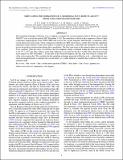Files in this item
Simulating the formation of a sigmoidal flux rope in AR10977 from SOHO/MDI magnetograms
Item metadata
| dc.contributor.author | Gibb, Gordon Peter Samuel | |
| dc.contributor.author | Mackay, Duncan Hendry | |
| dc.contributor.author | Green, Lucie | |
| dc.contributor.author | Meyer, Karen Alison | |
| dc.date.accessioned | 2014-08-14T11:31:02Z | |
| dc.date.available | 2014-08-14T11:31:02Z | |
| dc.date.issued | 2014-02-20 | |
| dc.identifier | 102315531 | |
| dc.identifier | bf49b0c7-b828-40fe-8834-c11872d3a2b7 | |
| dc.identifier | 84893582446 | |
| dc.identifier | 000334584700013 | |
| dc.identifier.citation | Gibb , G P S , Mackay , D H , Green , L & Meyer , K A 2014 , ' Simulating the formation of a sigmoidal flux rope in AR10977 from SOHO /MDI magnetograms ' , Astrophysical Journal , vol. 782 , no. 2 , 71 . https://doi.org/10.1088/0004-637X/782/2/71 | en |
| dc.identifier.issn | 0004-637X | |
| dc.identifier.other | ORCID: /0000-0001-6065-8531/work/58055434 | |
| dc.identifier.uri | https://hdl.handle.net/10023/5154 | |
| dc.description | G.P.S.G. acknowledges STFC for financial support. D.H.M. acknowledges the STFC, the Leverhulme Trust, and the EU FP7 funded project "SWIFF" (263340) for financial support. L.M.G. acknowledges to the Royal Society for a University Research Fellowship. K.A.M. acknowledges the Leverhulme Trust for financial support. Simulations were carried out on a STFC/SRIF funded UKMHD cluster at St Andrews. | en |
| dc.description.abstract | The modeling technique of Mackay et al. is applied to simulate the coronal magnetic field of NOAA active region AR10977 over a seven day period (2007 December 2-10). The simulation is driven with a sequence of line-of-sight component magnetograms from SOHO/MDI and evolves the coronal magnetic field though a continuous series of non-linear force-free states. Upon comparison with Hinode/XRT observations, results show that the simulation reproduces many features of the active region's evolution. In particular, it describes the formation of a flux rope across the polarity inversion line during flux cancellation. The flux rope forms at the same location as an observed X-ray sigmoid. After five days of evolution, the free magnetic energy contained within the flux rope was found to be 3.9 × 1030 erg. This value is more than sufficient to account for the B1.4 GOES flare observed from the active region on 2007 December 7. At the time of the observed eruption, the flux rope was found to contain 20% of the active region flux. We conclude that the modeling technique proposed in Mackay et al.—which directly uses observed magnetograms to energize the coronal field—is a viable method to simulate the evolution of the coronal magnetic field. | |
| dc.format.extent | 14 | |
| dc.format.extent | 1987849 | |
| dc.language.iso | eng | |
| dc.relation.ispartof | Astrophysical Journal | en |
| dc.subject | Sun: corona | en |
| dc.subject | Sun: coronal mass ejections (CMEs) | en |
| dc.subject | Sun: flares | en |
| dc.subject | Sun: X-rays, gamma rays | en |
| dc.subject | QB Astronomy | en |
| dc.subject | QC Physics | en |
| dc.subject | BDC | en |
| dc.subject.lcc | QB | en |
| dc.subject.lcc | QC | en |
| dc.title | Simulating the formation of a sigmoidal flux rope in AR10977 from SOHO/MDI magnetograms | en |
| dc.type | Journal article | en |
| dc.contributor.sponsor | Science & Technology Facilities Council | en |
| dc.contributor.sponsor | The Leverhulme Trust | en |
| dc.contributor.sponsor | European Commission | en |
| dc.contributor.institution | University of St Andrews. Applied Mathematics | en |
| dc.identifier.doi | https://doi.org/10.1088/0004-637X/782/2/71 | |
| dc.description.status | Peer reviewed | en |
| dc.identifier.grantnumber | ST/K000950/1 | en |
| dc.identifier.grantnumber | RPG-305 | en |
| dc.identifier.grantnumber | 263340 | en |
This item appears in the following Collection(s)
Items in the St Andrews Research Repository are protected by copyright, with all rights reserved, unless otherwise indicated.

